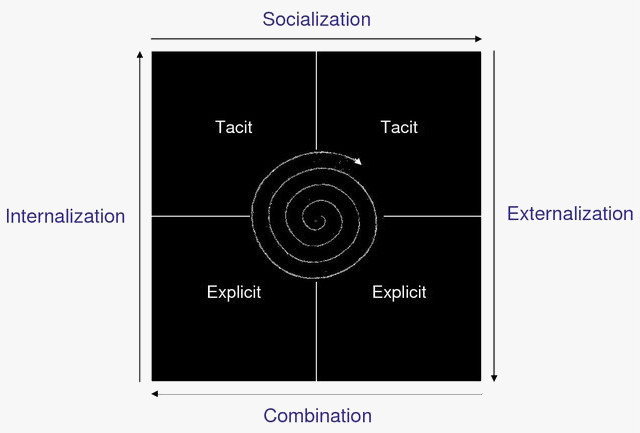Arguably the most important contributor to this subject has been Ikujiro Nonaka. He worked extensively with the concepts of explicit knowledge and tacit knowledge, and drew attention to the way Western firms tend to focus too much on the former (Nonaka & Takeuchi 1996). This sentiment has since been echoed throughout organisational learning and knowledge management (KM) literature (e.g. Cook & Brown 1999, Kreiner 1999, Tsoukas & Valdimirou 2001, etc.).
Nonaka and Takeuchi introduced the SECI model (Nonaka & Takeuchi 1996) which has become the cornerstone of knowledge creation and transfer theory. They proposed four ways that knowledge types can be combined and converted, showing how knowledge is shared and created in the organization. The model is based on the two types of knowledge outlined above.
- Socialization: Tacit to tacit. Knowledge is passed on through practice, guidance, imitation, and observation.
- Externalization: Tacit to explicit. This is deemed as a particularly difficult and often particularly important conversion mechanism. Tacit knowledge is codified into documents, manuals, etc. so that it can spread more easily through the organization. Since tacit knowledge can be virtually impossible to codify, the extent of this knowledge conversion mechanism is debatable. The use of metaphor is cited as an important externalization mechanism.
- Combination: Explicit to explicit. This is the simplest form. Codified knowledge sources (e.g. documents) are combined to create new knowledge.
- Internalization: Explicit to tacit. As explicit sources are used and learned, the knowledge is internalized, modifying the user's existing tacit knowledge.
The SECI Model Knowledge Creation Spiral
In this model, knowledge is continuously converted and created as users practice, collaborate, interact, and learn. The process should be seen as a continuous, dynamic, swirl of knowledge rather than a static model. It is basically a visual representation of overlapping, continuous processes that take place - or should take place - in an organization.
Below I have included a graphical representation of this concept as presented in the SECI model:

A great deal of effort has been put into investigating its practical applicability (with mixed results), but in recent years the applicability of the model has been linked strongly to culture, both organizational and national. The issue is whether culture is more than just an element in a KM model, i.e. culture-in-the-model, but rather acts as a limiting factor for a model, i.e. culture-of-the-model (Andreeva & Ikhilchik 2011). The issue of culture as a limiting factor for KM models is an issue I will incorporate into the site in the future and provide a link from this article to the new sections.
Nonetheless, the SECI model remains at the core of knowledge conversion theory within KM, and this almost universal attraction to the model may in itself be an indication that some aspects of it appeal to virtually all cultures (Andreeva & Ikhilchik 2011).
 Emil Hajric
Emil Hajric